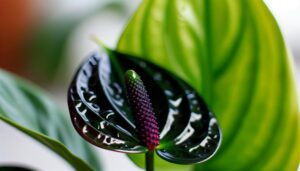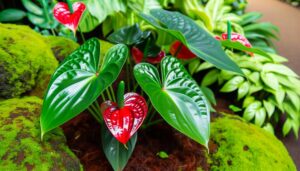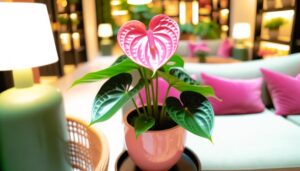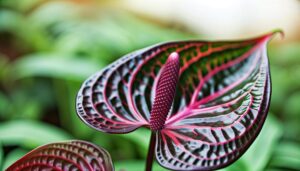Caring for Your Pink Anthurium Houseplant – A Step-by-Step Guide
To care for your pink anthurium, start by potting it in a container with drainage holes, preferably terra cotta. Position it in bright, indirect sunlight, rotating for even exposure.
Water when the top inch of soil is dry, maintaining proper drainage. Keep humidity levels at 60% or higher using a humidifier or misting daily.
Maintain temperatures between 65°F and 80°F, avoiding drafts. Inspect leaves weekly for pests and treat with insecticidal soap or neem oil if needed.
For yellowing leaves, check water levels, light, nutrients, and pests. Stay tuned for detailed protocols to maximize your anthurium's health.
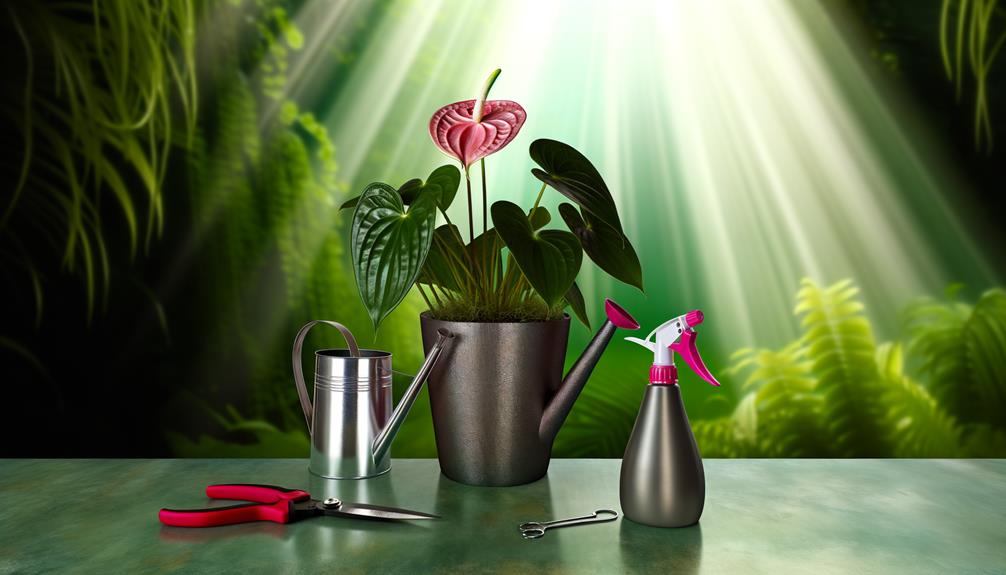
Key Takeaways
- Place your Pink Anthurium in bright, indirect sunlight and avoid drafty areas.
- Water when the top inch of soil is dry, ensuring proper drainage.
- Maintain humidity levels of at least 60% with a humidifier or pebble tray.
- Keep temperatures between 65°F and 80°F, avoiding sudden changes.
- Inspect for pests weekly and treat with insecticidal soap or neem oil if needed.
Choosing the Right Pot
Choosing the correct pot for your Pink Anthurium is crucial because it guarantees adequate drainage and promotes strong root development. Opt for a pot with drainage holes to prevent waterlogging, which can lead to root rot. Terra cotta pots are ideal as they're porous and allow excess moisture to evaporate.
Select a pot that's about 1-2 inches larger in diameter than the current one to avoid constraining the roots. Make sure the potting mix is well-aerated; a blend of orchid bark, perlite, and peat moss works wonders. Avoid pots that are too large, as they retain excess water, risking root damage.
Ideal Light Conditions
Ensuring your Pink Anthurium receives the proper light conditions is essential for ideal growth and vibrant blooms. Place your plant in a location with bright, indirect sunlight. Direct sunlight can scorch the leaves, while too little light will stunt its growth. A north or east-facing window is often optimal.
In winter months, you might need to supplement with a grow light to maintain adequate luminosity. Aim for light levels between 10,000 to 20,000 lux. Rotate your Anthurium every few weeks to guarantee even exposure and symmetrical growth. Avoid drafty areas, as temperature fluctuations can stress the plant.
Watering Schedule
To maintain ideal hydration for your Pink Anthurium, water when the top inch of soil feels dry to the touch.
Excess moisture can cause root rot, so look for signs of overwatering like yellowing leaves and a musty smell.
Ensuring proper drainage and a consistent watering schedule will keep your plant healthy.
Optimal Watering Frequency
For ideal growth, water your Pink Anthurium when the top inch of soil feels dry to the touch, typically once every 1-2 weeks, depending on environmental conditions. Use your finger to gauge soil moisture.
When watering, allow the water to permeate through the potting mix, allowing excess to drain from the bottom. This method prevents root rot and maintains prime hydration. Avoid letting your Anthurium sit in standing water, as it can lead to fungal infections.
Adjust your watering frequency based on indoor humidity levels, temperature, and light exposure. During winter months, your plant's water needs may decrease.
Consistency in your watering schedule fosters robust root development and vibrant blooms, ensuring your Pink Anthurium thrives in your care.
Signs of Overwatering
How can you tell if your Pink Anthurium is overwatered?
Look for yellowing leaves, which indicate hypoxia due to waterlogged roots.
Check the soil; if it's consistently soggy, you're overwatering.
Feel the leaves—if they're soft or mushy, cellular degradation might be occurring.
Inspect the roots; healthy ones are white, but overwatered roots turn brown and slimy due to anaerobic conditions.
Mold or fungal growth on the soil surface is another red flag.
Finally, a musty odor from the soil signals rot.
To prevent overwatering, ensure your pot has proper drainage and let the top inch of soil dry out between waterings.
Your Pink Anthurium will thrive with balanced hydration and attentive care.
Humidity Needs
Ensuring your pink anthurium thrives requires maintaining a humidity level of at least 60%, as these tropical plants flourish in moist environments. Use a hygrometer to monitor ambient humidity. If levels drop, employ a humidifier or place your plant on a pebble tray filled with water. Grouping plants together also elevates humidity through collective transpiration.
Mist your anthurium's leaves with distilled water daily, avoiding direct sunlight to prevent leaf burn. Alternatively, consider placing it in a naturally humid area, like a bathroom with indirect light. Avoid sudden fluctuations in humidity; consistent conditions are essential. If the leaf edges brown, it's a clear indicator of insufficient humidity.
Maintain vigilance, and your anthurium will reward you with vibrant, lush growth.
Temperature Requirements
To maintain your pink anthurium thriving, sustain a consistent temperature range between 65°F and 80°F. This tropical plant flourishes in warm conditions, avoiding sudden temperature fluctuations. Place it away from drafts, air conditioning vents, and heating units to prevent thermal stress. During winter, keep the room temperature doesn't drop below 60°F to avoid chilling injury.
Monitor indoor climate with a reliable thermometer, positioning your anthurium in a stable environment. If you're using artificial heating, ensure humidity levels remain high to counteract dryness.
Always aim for a balance, as excessively high temperatures can cause leaf scorch, while prolonged cold can inhibit growth. By maintaining these conditions, you'll create a prime environment for your pink anthurium's health and vibrancy.
Soil Mix
Equally important to maintaining ideal temperature is selecting a well-draining soil mix that mimics the anthurium's natural tropical habitat. Start by combining equal parts orchid bark, peat moss, and perlite. Orchid bark provides necessary aeration, preventing root rot.
Peat moss retains moisture without waterlogging, guaranteeing a balanced hydration level. Perlite enhances drainage and keeps the soil light, mimicking the forest floor where anthuriums thrive.
To mix, use a clean container and thoroughly combine the components to ensure consistency. Before planting, moisten the mix slightly to help roots establish. Avoid using regular potting soil; it compacts easily, suffocating roots.
Fertilization Tips
When fertilizing your pink anthurium, apply a balanced, water-soluble fertilizer every six to eight weeks during the growing season to guarantee vibrant blooms and healthy foliage. Dilute the fertilizer to half the recommended strength to avoid nutrient burn.
Make sure the soil is moist before application to ensure even distribution and absorption. Keep an eye on your plant's response and adjust the frequency if necessary.
- Choose a balanced N-P-K ratio: Opt for a 20-20-20 blend for best growth.
- Apply during the morning: This allows for efficient nutrient uptake.
- Avoid fertilizing in dormant periods: Typically during late fall and winter.
- Monitor for signs of over-fertilization: Yellowing leaves can indicate excess nutrients.
Pruning Techniques
After securing your pink anthurium is well-fertilized, you should focus on pruning to maintain its health and promote new growth. Start by sterilizing your pruning shears with rubbing alcohol to prevent infection.
Carefully remove any dead or yellowing leaves; these can harbor pests and diseases. Trim faded flowers at their base, encouraging the plant to redirect energy into producing new blooms. Always cut just above a node, the point where leaf stems attach to the main stem, to stimulate further growth.
Regular pruning will also help maintain the plant's shape, securing it remains aesthetically pleasing. Inspect your plant weekly, and prune as needed, but avoid over-pruning, which can stress the plant. Consistent care secures a vibrant, thriving anthurium.
Repotting Guide
Repotting your pink anthurium is necessary every 1-2 years to make sure it has enough space to grow and access fresh nutrients. For best results, follow these steps:
- Choose the appropriate pot: Select a container that's 1-2 inches larger in diameter than the current one to avoid root bound conditions.
- Prepare the soil: Use a well-draining mix, combining orchid bark, perlite, and peat moss.
- Remove the plant: Gently loosen the root ball, removing old soil and trimming any damaged roots.
- Replant and water: Place the anthurium in the new pot, fill with fresh soil, and water thoroughly to settle the roots.
Repotting ensures your pink anthurium thrives, allowing it to flourish with vibrant blooms and healthy foliage.
Pest Control
Ensuring your pink anthurium remains pest-free is just as essential as repotting it, requiring regular inspections and prompt action against common invaders like aphids, spider mites, and mealybugs.
First, inspect the undersides of leaves and stems weekly using a magnifying glass to detect early infestations. If pests are spotted, isolate the plant immediately.
For aphids and spider mites, use a gentle insecticidal soap, applying it thoroughly but avoiding flower bracts. Mealybugs require more attention; dab them with a cotton swab soaked in rubbing alcohol.
Enhance your plant's resilience by maintaining ideal humidity levels and avoiding over-fertilization. Consistent monitoring and appropriate interventions will keep your pink anthurium thriving and free from pest-related stress.
Common Issues and Solutions
You may encounter yellowing leaves on your Pink Anthurium due to overwatering or insufficient light.
To manage pest infestations, regularly inspect the plant for aphids, mealybugs, and spider mites, and use neem oil or insecticidal soap as needed.
Ensuring proper humidity and air circulation will also help maintain a healthy plant environment.
Yellowing Leaves Causes
Yellowing leaves on your pink anthurium often signify underlying issues like improper watering, nutrient deficiencies, or pests, which require immediate attention and precise corrective measures. To diagnose and remedy this problem:
- Check Watering Practices: Overwatering can lead to root rot, while underwatering stresses the plant. Confirm soil is moist but not soggy.
- Evaluate Light Exposure: Insufficient light can cause yellowing. Place your anthurium in bright, indirect sunlight.
- Nutrient Deficiency: Lack of essential nutrients, particularly nitrogen, can cause yellow leaves. Use a balanced, water-soluble fertilizer every 4-6 weeks.
- Inspect for Pests: Though pests will be discussed later, verify there are no visible signs on leaves or stems.
Address these factors to restore your anthurium's vibrant foliage.
Pest Infestations Management
Pests such as aphids, spider mites, and mealybugs can wreak havoc on your pink anthurium, causing damage that manifests as yellowing leaves, stunted growth, and a general decline in plant health.
To manage these infestations, start by isolating the affected plant to prevent the pests from spreading. Use a magnifying glass to identify the specific pest. For aphids, spider mites, and mealybugs, apply insecticidal soap or neem oil directly to the affected areas. Guarantee thorough coverage on both sides of the leaves. Repeat treatments every 7-10 days until the infestation subsides.
Maintain humidity levels, as dry conditions exacerbate pest issues. Regularly inspect your plant to catch infestations early, ensuring your pink anthurium remains vibrant and healthy.
Conclusion
Taking care of your pink anthurium is like nurturing a tiny, tropical paradise in your home. By selecting the right pot, providing ideal light, and adhering to a precise watering schedule, your plant will flourish.
Maintain high humidity, keep temperatures at their best, and prune regularly. Repot when needed and stay vigilant against pests.
With expert care, your anthurium will bloom so beautifully, it's as if you've captured a piece of the rainforest itself!



